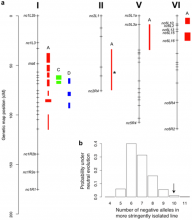Neurospora crassa individuals acting as females in southern India are faced with local suitors from their own species and from a sister species, N. intermedia. We wanted to know if “she” has a choice in the matter because fungi, in general, mate first and then ask if it was a good idea. It turns out that she does, possibly the first observation of mate choice in a microbe. In the case of these Indian N. crassa, if the suitor is an Indian N. intermedia, the answer is no and the female aborts the progeny. After a few days, she is ready to try again, in hopes of partnering with a member of her own species. We found, however, that she cannot recognize that the suitor is N. intermedia if he is visiting from the Caribbean or Africa. In these matings she puts all of her effort into making inviable progeny and cannot mate again. Using a QTL approach, we found 11 loci that affect the trait of female abortion and used them to show that this trait evolved to reinforce the baseline mating barriers that normally exist between the two species [Turner et al. 2011].

QTL for reinforced mating barriers in Neurospora. Turner et al. 2011. PLoS Genetics.

